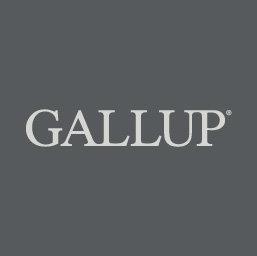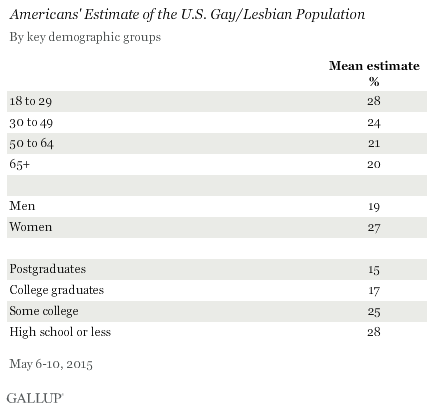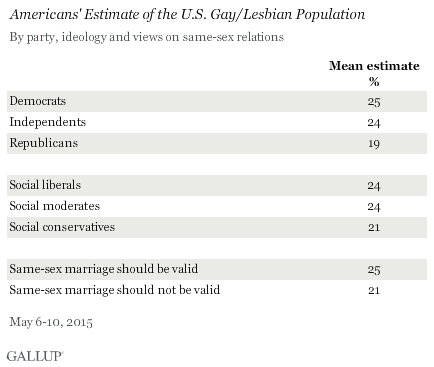
Americans Greatly Overestimate Percent Gay, Lesbian in U.S.
Story Highlights
- Estimate is similar to what was measured in 2011 and 2002
- Latest estimate shows that 3.8% actually identify as LGBT
- Estimates are lower among those with the most education
PRINCETON, N.J. -- The American public estimates on average that 23% of Americans are gay or lesbian, little changed from Americans' 25% estimate in 2011, and only slightly higher than separate 2002 estimates of the gay and lesbian population. These estimates are many times higher than the 3.8% of the adult population who identified themselves as lesbian, gay, bisexual or transgender in Gallup Daily tracking in the first four months of this year.

The stability of these estimates over time contrasts with the major shifts in Americans' attitudes about the morality and legality of gay and lesbian relations in the past two decades. Whereas 38% of Americans said gay and lesbian relations were morally acceptable in 2002, that number has risen to 63% today. And while 35% of Americans favored legalized same-sex marriage in 1999, 60% favor it today.
The U.S. Census Bureau documents the number of individuals living in same-sex households but has not historically identified individuals as gay or lesbian per se. Several other surveys, governmental and non-governmental, have over the years measured sexual orientation, but the largest such study by far has been the Gallup Daily tracking measure instituted in June 2012. In this ongoing study, respondents are asked "Do you, personally, identify as lesbian, gay, bisexual or transgender?" with 3.8% being the most recent result, obtained from more than 58,000 interviews conducted in the first four months of this year.
As Gallup pointed out in its initial report of LGBT data in 2012, "Exactly who makes up the LGBT community and how this group should be measured is a subject of some debate," and "There are a number of ways to measure lesbian, gay, and bisexual orientation, and transgender status. Sexual orientation can be assessed by measuring identity as well as sexual behaviors and attractions." Thus, even though these large sample sizes provide great precision regarding the specific measure used, they do not represent the only way to estimate the percentage of the population that is gay or lesbian.
Still, all available estimates of the actual gay and lesbian population in the U.S. are far lower than what the public estimates, and no measurement procedure has produced any figures suggesting that more than one out of five Americans are gay or lesbian. The widely off-the-mark nature of Americans' estimates is underscored by the finding that in the most recent update, from May 6-10, only 9% of Americans estimate that the gay and lesbian population is less than 5% -- where Gallup's tracking figure would put it -- while at the other end of the spectrum, 33% estimate it as more than 25%.
Part of the explanation for the inaccurate estimates of the gay and lesbian population rests with Americans' general unfamiliarity with numbers and demography. Previous research has shown that Americans estimate that a third of the U.S. population is black, and believe almost three in 10 are Hispanic, more than twice what the actual percentages were as measured by the census at the time of the research. Americans with the highest levels of education make the lowest estimates of the gay and lesbian population, underscoring the assumption that part of the reason for the overestimate is a lack of exposure to demographic data. Still, the average estimate among those with postgraduate education is 15%, four times the actual rate. Younger Americans give higher estimates than those who are older, and women make significantly higher guesses of the gay and lesbian population than men do.

Republicans and conservatives are much less likely than others to consider gay and lesbian relations morally acceptable and to favor legalized same-sex marriage, and Republicans provide estimates of the gay and lesbian population that are somewhat lower than those made by other party groups. Similarly, those who are opposed to legalized same-sex marriage give modestly lower estimates of the gay population than those who favor it. The causality in these relationships could run both ways; attitudes toward gays and lesbians could be conditioned by views of how prevalent they are in the population, or estimates of their prevalence could reflect underlying attitudes toward the group.

Bottom Line
Americans perceive that more than one in five Americans are gay or lesbian, far greater than the actual rate as measured by self-reports on Gallup Daily tracking. Some of the overestimation may reflect Americans' lack of knowledge about social statistics and demography, which is supported by Americans' historical tendency to overestimate the prevalence of other subgroups in the U.S. population. The overestimation may also reflect prominent media portrayals of gay characters on television and in movies, even as far back as 2002, and perhaps the high visibility of activists who have pushed gay causes, particularly legalizing same-sex marriage. Still, the estimates of gay and lesbian percentages have been relatively stable compared with those measured in 2011 and 2002, even though attitudes about gays and lesbians have changed dramatically over that time.
Survey Methods
Results for this Gallup poll are based on telephone interviews conducted May 6-10, 2015, with a random sample of 1,024 adults, aged 18 and older, living in all 50 U.S. states and the District of Columbia. For results based on the total sample of national adults, the margin of sampling error is ±4 percentage points at the 95% confidence level. All reported margins of sampling error include computed design effects for weighting.
Each sample of national adults includes a minimum quota of 50% cellphone respondents and 50% landline respondents, with additional minimum quotas by time zone within region. Landline and cellular telephone numbers are selected using random-digit-dial methods.
View survey methodology, complete question responses, and trends.
Learn more about how Gallup Poll Social Series works.
